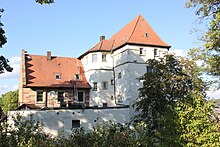Neuburg Castle (Baden)
Neuburg Castle is a castle located near Obrigheim (Baden) on a hill above the Neckar.
history
The castle was first mentioned in 1384 . At that time, the system was owned by Berthold Vetzer von Obrigheim. In 1401 Vetzer sold the castle to King Ruprecht von der Pfalz , who pledged the complex in 1405 to the widow of the Margrave of Baden, Mechthild von Sponheim . Released around 1413 by Count Palatine Otto I von Mosbach, the castle was repeatedly given to deserving Palatine vassal families from 1424 by the Mosbach Count Palatine or the Count Palatine near Rhine : from 1424 to von Wittstatt, called von Hagenbach, from 1468 to that of Massenbach, from 1482 to the Sinolt von Rheinheim, and from 1505 to the Lords of Rossau . During the Thirty Years' War , the Bavarian government awarded the complex to Chancellor Georg Friedrich von Isselbach , who lost the fief in 1648. After that, the Neuburg was owned by the Cloos family and later by the Mezger family. For a long time, the Neuburg fiefdom also included the Schreckhof , which was run down when Joseph Franz Xaver von Mezger died in 1747 and was confiscated by the court chamber and parceled out as an inheritance. In 1759, Neuburg Castle was finally left to a farmer from Obrigheim and his heirs as inheritance.
In 1845, Count Karl Wenzeslaus von Leiningen-Billigheim acquired the complex and then had it converted into a castle in the style of castle romanticism . In the first half of the 20th century the facility was often empty and was used as a district training castle for the NSDAP during the Third Reich . The castle has served as a hotel and restaurant since 1959.
The wrong name "Hohinrot"
In the older literature, the synonym Burg Hohinrot for Schloss Neuburg often appears without the complex ever bearing this name. The name appears for the first time with Johann Goswin Widder in his attempt to provide a complete geographical and historical description of the Kurfürstl. Pfalz am Rheine from 1786. Widder names the Nuweburg zu Oberkeim, otherwise called Hohinrot . This equation is presumably based on a reading error in old documents, since already in the fiefdom confirmation of 1424 a piece of forest that haderholtz located in Hohenrode was mentioned as belonging to the castle and was repeatedly associated with in other documents from the 15th and 16th centuries the castle is mentioned. In fact, the elevation behind Neuburg Castle is still referred to as the Hohe Rot and there is no mention of this name before 1424, while the castle appears as Neuburg as early as 1384. Fatally, during the renovation in 1845, the Count of Leiningen had an inscription, probably influenced by Aries, affixed to the outside staircase of the extension to the residential tower, stating that the castle was first called Hohinrot and then Neuburg. The erroneous name of the castle spread for a long time through the information provided by Widder and this inscription.
literature
- Nicolai Knauer: Hohinrot, Phantomburg am Neckar , in: Kraichgau. Contributions to landscape and local research , volume 18, 2003, pp. 99-101.
- Sebastian Parzer: The history of the Neuburg , in: Obrigheim - yesterday and today 9 (1999), pp. 29–32.
- Horst Uhl: From the manor to the count's residence - Neuburg Castle in the 19th century , in: Obrigheim - yesterday and today 1 (1991), pp. 31–34.
- Eckhard Hoffmann: The Neuburg before the renovation of 1845/46: archive finds convey new knowledge about the old castle complex , in: Unser Land 1988, pp. 62–65.
- Fritz Liebig: Neuburg Castle in the Neckar Valley , in: Badische Heimat 1957, pp. 241-251.
Web links
Individual evidence
- ^ Johann Goswin Widder: Attempt of a complete geographical-historical description of the Kurfürstl. Pfalz am Rheine , Volume 2, Frankfurt and Leipzig, p. 95 ( digitized from digital-sammlungen.de).
- ↑ This is also the case with Liebig 1957, p. 242, who refers to Widder and tries to establish a connection between the Lords of Heinriet and Obrigheim via the Lords of Weinsberg and sees the Heinrietes as the possible builders of the castle.
Coordinates: 49 ° 20 ′ 38.5 " N , 9 ° 5 ′ 43" E





